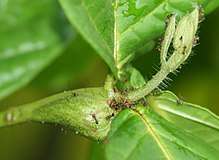Devil's garden
In myrmecology and forest ecology, a devil's garden (Kichwa: Supay chakra[1][2]) is a large stand of trees in the Amazon rainforest consisting of at most three tree species and the ant Myrmelachista schumanni.[2] Devil's gardens can reach up to sizes of 600 trees and are inhabited by a single ant colony, containing 3 million workers and 15,000 queens.[1][3] In a 2002 to 2004 census of the Amazon, devil's gardens were shown to have grown by 0.7 percent per year.[4] The relationship between tree and ant may persist for more than 800 years.[3][4]

Background
Devil's gardens got their name because locals believed that an evil forest spirit Chullachaki (meaning "uneven foot, single foot" in Kichwa) or Chuyathaqi lived in them.[5][6]
Types
Inhabited by the ant Myrmelachista schumanni, devil's gardens, in different regions of the Amazon, can be dominated by different tree species.[1] In southeastern Peru, devil's gardens are dominated by Cordia nodosa (Boraginaceae) and occasionally mixed with Tococa occidentalis (Melastomataceae).[2][7] At higher elevations, the tree species Tapirira guianensis (Anacardiaceae) can be found dominating gardens.[2] In southeastern Ecuador and northeastern Peru the most common tree species found in devil's gardens are Duroia hirsuta (Rubiaceae).[2]
Symbiosis

The mutualistic symbiosis between the ant Myrmelachista schumanni and the tree Duroia hirsuta begins when an ant queen colonizes an isolated tree.[1] The ants make nesting sites in the hollow stems and leaves of the tree, called domatia.[4][7] The ants eliminate competition for the tree by poisoning all plants, except the host tree, with formic acid.[3] Because other plants are killed off, D. hirsuta saplings are able to grow and the ant colony is able to expand.[3][4]
The tree provides shelter (hollow stems and domatia) and food (leaves) for the ants,[7] and the ants provide a suitable environment for the trees to grow by eliminating competing plants.[7] Although the ants fend off herbivores, the size of the garden is restricted by leaf destruction increasing as it expands, as the ants are unable to defend the trees beyond a certain point.[1][6]
References
- Frederickson, M. E., & Gordon, D. (2007). The devil to pay: the cost of mutualism with Myrmelachista schumanni ants in 'devil's gardens' is increased herbivory on Duroia hirsuta trees. Proc. R. Soc. B. 274 (1613): 1117-23.
- David P. Edwards, Megan E. Frederickson, Glenn H. Shepard, and Douglas W. Yu (2009): A Plant Needs Ants like a Dog Needs Fleas: Myrmelachista schumanni Ants Gall Many Tree Species to Create Housing. The American Naturalist 174, no. 5: pp. 734-740.
- Frederickson, M. E., Greene, M. J., & Gordon, D. (2005). Ecology: 'Devil's gardens' bedevilled by ants. Nature 437: 495-6.
- Shwartz, Mark (2005-09-26). "Ants, not evil spirits, create poisonous devil's gardens in the Amazon rainforest". Stanford University. Retrieved 2019-12-03.
- Pablo Amaringo: Ayahuasca Visions - "a vision of the Supay-chacra or garden of the Chullachaki."
- BBC News: Devilish ants control the garden. 21 September 2005. Retrieved August 12, 2006.
- Morawetz, Wilfried; Henzl, Martin; Wallnöfer, Bruno (1992-03-01). "Tree killing by herbicide producing ants for the establishment of pureTococa occidentalis populations in the Peruvian Amazon". Biodiversity & Conservation. 1 (1): 19–33. doi:10.1007/BF00700248. ISSN 1572-9710.